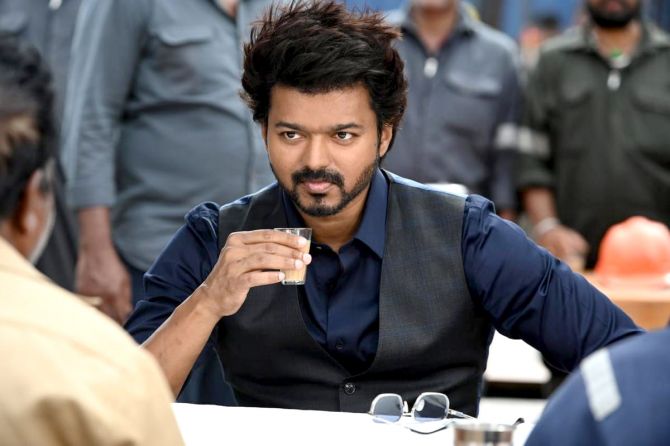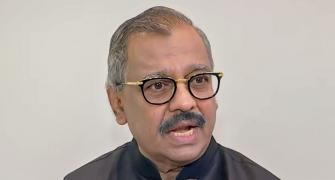'In terms of ticket sales, Hindi is at 50-60 per cent while the South markets are at 80-90 per cent of pre-pandemic levels.'
The patchy performance of Hindi, the largest segment of the business, is the nub of what is bothering Indian cinema.

Abhishek Pathak's Drishyam 2, the official Hindi remake of the eponymous Malayalam hit, is a gripping watch.
As Vijay Salgaonkar tries to protect his family from the consequences of an accidental murder the twists and turns in the plot make you bite your nails in worry.
The mid-sized film made, reportedly, on a budget of Rs 50 crore (Rs 500 million) ended up with Rs 340 crore (Rs 3.4 billion) at the global box office last year.
Many more Drishyams are needed if the Indian film business has to recover fully from the double whammy of the pandemic and streaming.
That is the first point of note on the state of Indian cinema today. These bread-and-butter fillers between blockbusters get audiences to keep coming back to theatres, ensuring they are financially hydrated.

Drishyam 2 came soon after big budget hits Brahmastra and RRR. And just before one of the biggest Hindi hits, Pathaan. All of them have perked up the business (see chart).
Pathaan actually helped 25 single screens come back to life. Almost every major retailer is investing in screens.
PVR Inox is opening 168 new screens this year even as it decommissions 50 old ones.
Miraj, Carnival, Cinepolis, almost every major chain is investing in more screens. But the pipeline of mid-budget films for India's almost 9,000 screens remains a worry.
"There is no confusion as far as the big movies are concerned. It is the mid-sized films where they (the Mumbai film fraternity) are thinking creatively how we connect with audiences more. Which they did earlier with films like Andhadhun (2018) and Kahaani (2012).
Now these are few and far in between," says Ajay Bijli, managing director, PVR Inox, India's largest film retailer.
"The Hindi-speaking market is down because content flow is down," says Rajesh Mishra, executive director and group CEO, UFO Moviez.

The Hindi movie situation
That is the nub of what is bothering Indian cinema -- the patchy performance of Hindi, the largest segment of the business.
"(In terms of ticket sales) Hindi is at 50-60 per cent while the South markets are at 80-90 per cent of pre-pandemic levels," says Amit Sharma, managing director, entertainment, Miraj Group, which owns 185 screens across India.
He reckons that revenues are back to over 80 per cent of pre-pandemic levels due to ticket price rises.
From Rs 19,100 crore (Rs 191 billion) in 2019, total cinema revenue crashed to Rs 7,200 crore (Rs 72 billion) in 2020.
Last year, it climbed back to Rs 17,200 crore (Rs 172 billion). About 994 million Indians bought tickets and went to see a film in a theatre in 2022.
That is a very good number, but it is still far from the pre-pandemic total of 1.46 billion tickets. (Much of this data is from FICCI-EY reports.)
India reflects what is happening elsewhere in the world.
"Things are moving to normalcy. In France business is back to 88 per cent, in the UK 82 per cent, and in the US 76 per cent of pre-pandemic levels," says David Hancock, chief analyst, media and entertainment at London-based Omdia.
The worry is that the supply of films has gone to about half of pre-Covid levels and that means there is "less opportunity to generate revenues. This year is not seeing the same level of mid-budget films", says Hancock.
The pandemic had knocked film production off schedule across the world.
From Mission Impossible: Dead Reckoning to Maidaan and Jawan every major release both in Hollywood and in India has been delayed. That will take time to recover.
"The habit of going to the cinema is broken and getting it back is taking time," says Hancock.
That is the second point of note on the state of the business.
A combination of some world-class films and shows on streaming has meant that audiences are not just sated but reluctant to step out.
More importantly their palette has changed -- permanently.
A Kahaani or Andhadhun, both successful mid-budgeters, may not be guaranteed an audience today.
The expectations from storytelling, especially in the mid-sized films that are consumed more on OTT, have gone sky-high.
Big-budget spectacle films somehow escape cinematic scrutiny.
The expectations from them are pure paisa-vasool (value-for-money) entertainment which the Marvel movies or even RRR and Pathaan provided wonderfully.
"Content makers are trying to crack the code but we might have lost some audiences forever," thinks Sharma.

The Southern symphony
That brings the question -- why have the same factors that affect Hindi not affected Tamil, Telugu, Malayalam and Kannada cinema?
Analysts reckon that is because the market is structurally different from Hindi in three critical ways.
One, there is simply not enough content in South Indian languages on OTT.
As a result, streaming has simply not taken off in the South the way it has in Hindi-speaking markets.
Two, the five Southern states are single-screen dominated markets.
In the two Telugu speaking states, which are among the largest cinema consumers in India, big producers control single screens and determine the timing and nature of a release.
This backward integration then keeps the market hydrated with big spectacle hits.
Three, in Tamil Nadu the local government regulates ticket prices.
This has ensured that multiplexes, which generally have higher average prices, haven't gained ground.
Hindi operates in a more competitive market dominated by multiplexes.
"Every few decades a phase happens when change has to be brought about creatively. OTT is forcing everyone to look at the kind of content they are making. There is bound to be a fatigue factor with OTT as well," says Bijli.
He adds: "We were knocked out like a boxer is (by the pandemic), but the counting to 10 has still not finished. We are bound to bounce back. It is a matter of two quarters."

Feature Presentation: Aslam Hunani/Rediff.com









